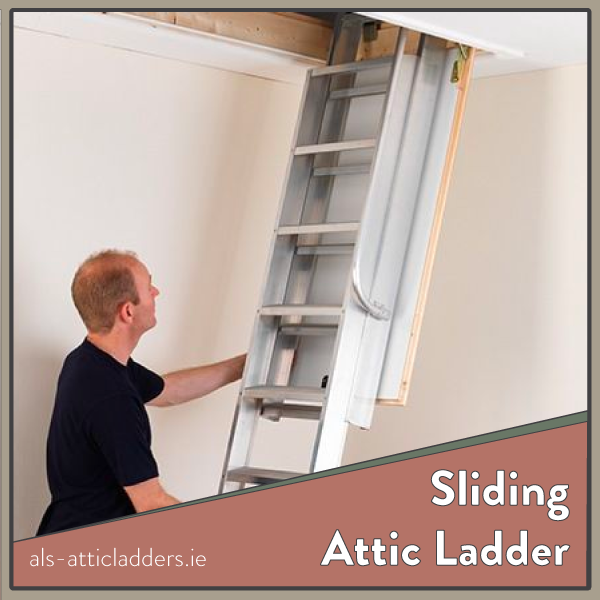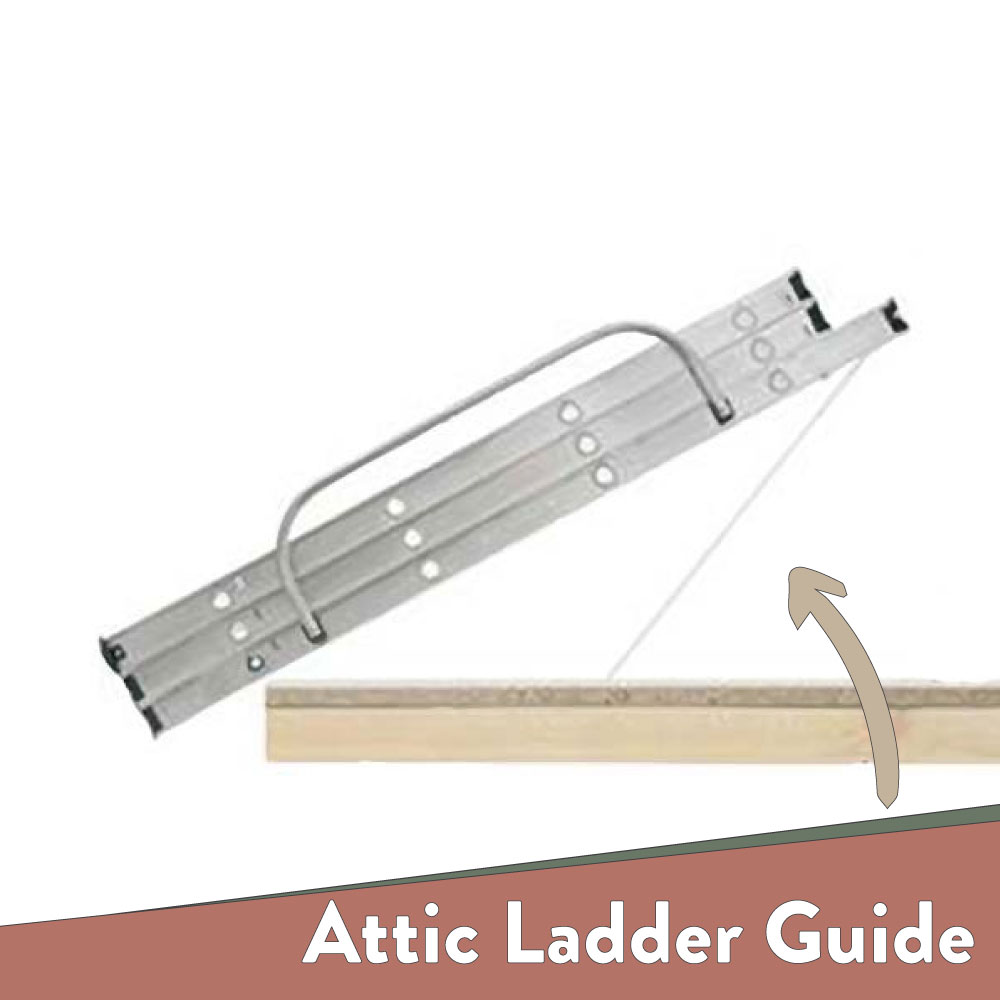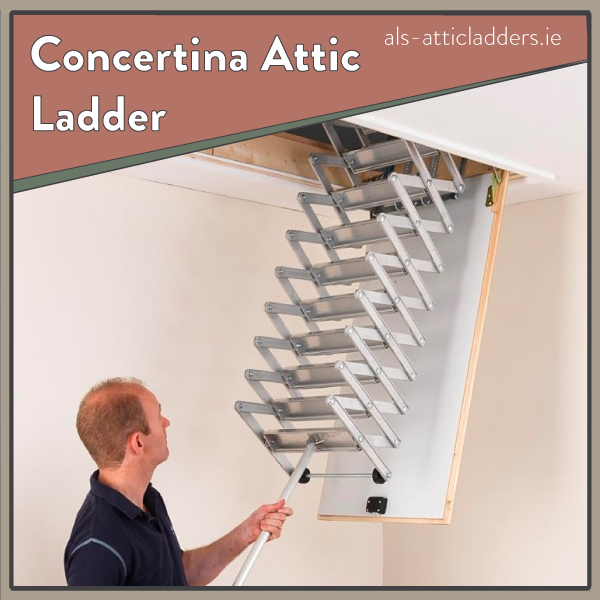Knowing how an attic ladder works can help you choose the right attic ladder for your needs. This post will touch on the basic way in which an attic ladder works, and the benefits and limitations of different designs. If you are considering a new attic opening please see our blog covering this topic.
The purpose of an attic ladder is to give you convenient access to your attic, as such all attic ladders (when professionally installed) come with a way of opening your attic door without use of a step or step ladder. For a cost effective aluminium attic ladder for example your attic door is converted to a hinged door, and a latch is fitted. This allows you to open the attic door with the use of a provided pole.
But how does an attic ladder work? Depending on the design some attic ladders will lower with the attic door or be completely independent. There are also different ways in which an attic ladder is lowered, some are spring assisted and some require the weight to be taken by the user.
Attic ladders can be broken into four main categories; Sliding attic ladders, folding attic ladders, Concertina attic ladders and Telescopic Attic Ladders. Let’s look at the different types and then answer the question, how does an attic ladder work. From the attic door to how attic ladders pull down and are stowed away.
Sliding Attic Ladders

Sliding attic ladders as the name suggests slide to be extended or retracted. Sliding attic ladders have a few differences in features but essentially operate in the same way. The ladder operates on a hinge, the hinge allows the ladder to slide up and down form the attic and to pivot into the attic. The ladder is built in sections, that extend and retract, this allows for minimum stow away space and clearance even in small attic openings.
Features to look out for depending on design.
Guides

Lightweight attic ladders, usually are supplied with a guide of some sort. The guide is fitted in the attic and essentially moves the ladder in the right direction, this make operating the ladder very easy as the ladder won’t move side to side when stowing it away. See the image below, a simple solution!
Some manufacturers include an assistance spring in the guide this not only guides the ladder but take some effort out of the pushing away. The drawback to this design is they can be more expensive and tend to fail sooner than the simple design above.
Door attachment

For very heavy duty sliding attic ladders the door is attached to the ladder as you can see in the image below. This is due to the fact that these attic ladders are for higher ceilings and as such require a bigger opening, the bigger opening requires a bigger/heavier door. To allow for safe opening of a heavy door, the ladder has spring assisted lowering that also takes the weight of the door.
General steps of use of the average sliding attic ladder:
The attic door is unlatched with the pole provided and is lowered while you take the weight of the door. The pole is then used to pull the attic ladder down to the point that you take the weight. The ladder is lowered fully, each section is then released/secured by disengaging/engaging the latch. To stow the ladder away the same process is followed in reverse. It is a very simple process once done once or twice. If your ladder is installed by us don’t worry we will show you exactly how it is done and answer any questions you may have.
Folding Attic Ladders

Folding attic ladders are made from wood and are fitted very differently to the sliding attic ladders. The folding attic ladder is one unit, both the attic door and ladder are combined. They generally all come with spring assistance and a solid guide built into the door and frame. This design makes lowering the ladder as easy as the sliding attic ladder even though it is much heavier.
Features to look out for depending on design.
This type of attic ladder can have the spring on the door or in the opening, both work equally well so in terms of function most are pretty equally made. Other feature worth looking out for are a good handrail (a great safety feature), Plastic feet, and most of all the insulation property of the door/unit. If you really value the extra insulation see the gold star, the best rated insulation on the market.
General steps of use of the average folding attic ladder:
The door is unlatched by pulling the circular catch with a pole, then lowered with the ladder attached. The ladder is then unfolded by hand (no pole required). To the stow the ladder away the same is repeated in reverse, with the door catch pushed up until clicked into place.
Concertina Attic Ladders

The concertina attic ladder is more of a specialty ladder and is reserved for use in very unique situations, where you might have a small hatch and a very tight space in the attic. They extend and retract like an accordion you might be able to imagine from the image above. Just like the sliding attic ladder they are usually independent of the attic door but can come with a door attachment. They usually have a spring to keep them stowed away as they don’t push away into the attic, but stay above the door.
Features to look out for.
Concertina attic ladders are usually similar in the way they operate however some great features are rubber steps, an included handrail, and insulated door.
General steps of use of a concertina attic ladder:
Just like above, a pole is provided to open the door and pull the attic ladder down. The ladder is then extended to the floor by hand. The same in reverse to stow it away.
Telescopic Attic Ladders

The Telescopic attic ladder is again a specialty ladder, they are expensive but are great for small attic spaces. They like the above ladders they usually are fitted independent of your attic door. The clever telescopic operation allows for quick use, and a very compact stowing space.
Features to look out for.
With this attic ladder I would look out for a reliable manufacturer rather than any feature. This type of ladder is relatively new on the market and has a lot of moving parts. A good manufacturer will have a strong spring and replacement parts if necessary.
General steps of use of the Telescopic attic ladder:
Using these ladders is straight forward, a pole is supplied to pull the ladder down from the attic. The ladder is then detached from the metal frame to allow it to be extended. Once extended it can be used and put back very quickly thanks to its quick telescopic action.
Conclusion
Those are the main categories of attic ladders and how they work, with that I hope I have clearly answered the question, How does an Attic Ladder work. I hope you are more informed on your options and what might suit you. If you would like another perspective on choosing an attic ladder see our blog post that discusses just that. We at Al’s Attic Ladders fit the first two categories of attic ladders as they suit ninety percent of customers situations. If you have any questions or need guidance please Call Us, or send us a WhatsApp or Email – [email protected]. We install attic ladders in all of County Dublin.
One Response